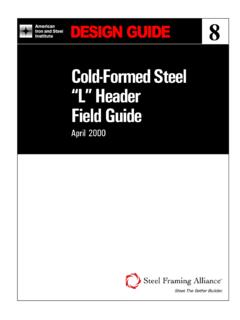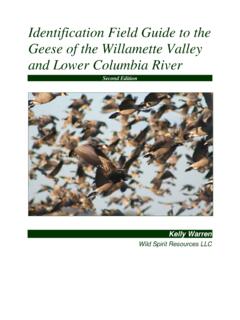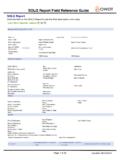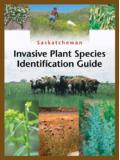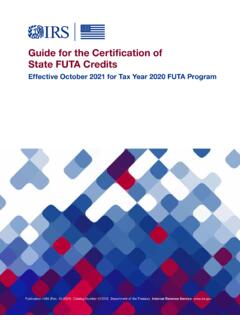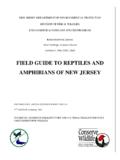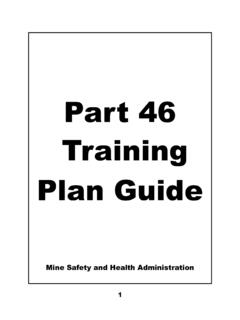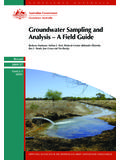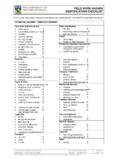Transcription of ERDC/CRREL TR-08-12, A Field Guide to the Identification ...
1 ERDC/CRREL TR-08-12. A Field Guide to the Identification of the Ordinary High Water Mark (OHWM) in the Arid West Region of the Western United States A Delineation Manual Robert W. Lichvar and Shawn M. McColley August 2008. and Engineering Laboratory Cold Regions Research Approved for public release; distribution is unlimited. ERDC/CRREL TR-08-12. August 2008. A Field Guide to the Identification of the Ordinary High Water Mark (OHWM) in the Arid West Region of the Western United States A Delineation Manual Robert W. Lichvar and Shawn M. McColley Cold Regions Research and Engineering Laboratory Army Engineer Research and Development Center 72 Lyme Road Hanover, NH 03755-1290. Approved for public release; distribution is unlimited. Prepared for Army Corps of Engineers Wetland Regulatory Assistance Program ii ERDC/CRREL TR-08-12. Abstract: The Ordinary High Water Mark (OHWM) is an approach for identifying the lateral limits of non-wetland waters.
2 However, determining whether any non-wetland water is a jurisdictional Water of the United States (WoUS) involves further assessment in accordance with the regulations, case law, and clarifying guidance. In the Arid West region of the , the most problematic Ordinary High Water (OHW) delineations are associated with the ephemeral/intermittent channel forms that dominate the Arid West landscape. This report presents a method for delineating the lateral extent of the non-wetland waters in the Arid West using stream geomorphology and vegetation response to the dominant stream discharge. DISCLAIMER: The contents of this report are not to be used for advertising, publication, or promotional purposes. Citation of trade names does not constitute an official endorsement or approval of the use of such commercial products. All product names and trademarks cited are the property of their respective owners. The findings of this report are not to be construed as an official Department of the Army position unless so designated by other authorized documents.
3 DESTROY THIS REPORT WHEN NO LONGER NEEDED. DO NOT RETURN IT TO THE ORIGINATOR. ERDC/CRREL TR-08-12 iii Contents Preface .. vi 1 Introduction ..1. Ordinary High Water (OHW) in the Arid West Region ..1. Scope of Manual ..2. Stream Geomorphology ..3. Hydrology ..5. Arid West Channel Forms of Interest ..6. Alluvial Fans .. 7. Compound 8. Discontinuous Ephemeral 9. Single-Thread Channels with Adjacent Anastomosing Flood Cycles and Effective Discharge .. 12. Human Disturbance .. 18. 2 OHWM Delineation Background .. 20. OHWM Indicators .. 20. OHWM Indicator 28. Identification of the Active 31. Arid West OHW Active Floodplain .. 33. 3 OHWM Identification 35. Resources Needed .. 35. Aerial Photography and Other Imagery ..35. Topographic Maps ..37. Other Rainfall Stream Gage Data ..42. Existing Preliminary Delineation 43. Field Verification of the Preliminary Delineation .. 49. Problematic Boundaries .. 60. Examples of Delineations by Channel 61.
4 Alluvial Fans ..61. Compound Discontinuous Ephemeral Streams ..63. Single-Thread Channels with Adjacent Anastomosing Rivers ..64. References .. 66. Report Documentation Page .. 77. iv ERDC/CRREL TR-08-12. Figures and Tables Figures Figure 1. Geographic extent of the Arid West region ..2. Figure 2. Representative cross sections depicting hydrogeomorphic floodplain units for perennial channel forms and intermittent/ephemeral channel forms ..3. Figure 3. Shift in the low-flow channel following a 5- to 10- year discharge event at Mission Creek, CA ..5. Figure 4. Alluvial fan with distributary channels at the confluence of the Colorado River and Bright Angel Creek, Grand Canyon, AZ ..7. Figure 5. Compound channel with a low-flow feature in the foreground, Mojave River, CA ..9. Figure 6. Erosional reach (arroyo) along a discontinuous ephemeral channel, Susie Creek, NV ..9. Figure 7. Single-thread channel with adjacent floodplain, Alter Wash, NV.
5 10. Figure 8. Anastomosing channels along Cooper Creek, Australia .. 11. Figure 9. Changes in channel form along an ephemeral stream channel .. 12. Figure 10. Model of changes within the active floodplain and low-flow channel associated with discharge events .. 13. Figure 11. Pre-effective discharge and post-effective discharge on the Mojave River at Afton Canyon .. 14. Figure 12. Aerial photo time-series acquired over a section of the San Carlos River, AZ, and their corresponding annual peak-flow hydrograph .. 17. Figure 13. Lateral and longitudinal variability of geomorphic indicator position along a hypothetical Arid West channel form .. 22. Figure 14. Hydrogeomorphic units and OHWM indicator positions within the Mission Creek study reach .. 29. Figure 15. Mean one standard deviation for each indicator type identified within the Mission Creek study reach .. 29. Figure 16. Conceptual model showing the locations of OHW indicators.
6 30. Figure 17. Active floodplain/low terrace boundary in an Arid West channel .. 32. Figure 18. Vegetative shift at the active floodplain/low terrace boundary in an Arid West channel .. 32. Figure 19. Examples of changes in vegetative cover and species between the active floodplain and the low terrace .. 34. Figure 20. Aerial photograph acquired over Chinle Creek, AZ .. 36. Figure 21. Section of a topographic map of the Fried Liver Wash Quadrangle, CA .. 38. Figure 22. Section of a geologic/topographic map of the Frazier Creek Quadrangle, NV .. 39. Figure 23. General vegetation map of New Mexico .. 40. Figure 24. Section of a soils map of the Frasier Flat Quadrangle, NV .. 41. Figure 25. Distribution of precipitation over a portion of northern California .. 42. ERDC/CRREL TR-08-12 v Figure 26. Flood frequency analysis results produced by HEC-SSP in accordance with Bulletin 17B for the Puerco River, near Chambers, AZ, and for the Mojave River at Afton Canyon, CA.
7 45. Figure 27. Discharge values associated with 2-, 5-, 10-, and 25-year events for gage 09396100 on the Puerco River near, Chambers, AZ, and for gage 10263000 on the Mojave River at Afton Canyon, CA .. 46. Figure 28. Discharge history for the Puerco River near Chambers, AZ, and for the Mojave River at Afton Canyon, CA .. 47. Figure 29. Shift-adjusted rating curve for gage 09396100 on the Puerco River, near Chambers, AZ, and for gage 10263000 on the Mojave River at Afton Canyon, CA .. 48. Figure 30. Step 1 of the Field verification procedure .. 49. Figure 31. Step 2 of the Field verification procedure .. 50. Figure 32. Step 3 of the Field verification procedure .. 51. Figure 33. Step 4 of the Field verification procedure .. 52. Figure 34. Step 5 of the Field verification procedure .. 53. Figure 35. Step 6 of the Field verification procedure .. 54. Figure 36. Step 7 of the Field verification procedure .. 55. Figure 37.
8 Step 8 of the Field verification procedure .. 55. Figure 38. Staff used to determine stage height for Chinle Creek, AZ .. 56. Figure 39. Projection onto the landscape of the stage height associated with the most recent effective discharge that exceeded a 5-year 57. Figure 40. Example geomorphic mapping of a compound channel showing a mosaic of terraces within the active floodplain, Caruthers Creek, CA .. 62. Figure 41. Example geomorphic mapping of a discontinuous ephemeral stream in an erosional reach (arroyo), Susie Creek, NV .. 63. Figure 42. Example geomorphic mapping in a straight reach of a single-thread channel with an adjacent floodplain, Alter Wash, AZ .. 64. Tables Table 1. Comparison by stream type of flood return interval and features associated with hydrogeomorphic position ..4. Table 2. Primary measurable alluvial fan characteristics ..8. Table 3. Natural controls on fluvial processes .. 15. Table 4.
9 Human controls on fluvial processes .. 19. Table 5. Potential geomorphic OHWM indicators categorized by location below, at, and above ordinary high water .. 21. Table 6. Potential vegetation OHWM indicators categorized by location below, at, and above ordinary high water .. 21. Table 7. Select geomorphic OHWM indicators that may be present below, at, and above the OHW boundary .. 23. Table 8. Select vegetative OHWM indicators that may be present below, at, and above the OHW boundary .. 27. Table 9. Websites with access to digital imagery .. 37. vi ERDC/CRREL TR-08-12. Preface This manual was prepared by Robert W. Lichvar and Shawn M. McColley, both of the Remote Sensing/GIS and Water Resources Branch, Cold Regions Research and Engineering Laboratory (CRREL), Army Engineer Research and Development Center (ERDC), Hanover, NH. Support and funding for this manual was provided by the Army Corps of Engineers (USACE), Headquarters (HQ) through the Wetland Regula- tory Assistance Program (WRAP).
10 Their support is acknowledged and appreciated. Dr. Mark Sudol and Katherine Trott (HQ) are acknowledged for their continued interest and support for this Arid West initiative, which addresses questions unique to this region of the country. Peer reviews, both external and internal, were provided by Dr. Yong Chung, USACE, Los Angeles District; Dr. Steven Daly, CRREL; Dr. John Field , Field Geologic Services; Dr. Richard French, University of Texas at San Antonio, San Antonio, TX; Dr. David Goldman, CRREL; and Dr. Eric Stein, Southern California Coastal Research Project, Westminster, CA. In addition, technical reviews of various drafts of this manual were provided by Dr. Aaron Allen, USACE, Los Angeles District; Marjorie Blaine, USACE, Los Angeles District; Ann Campbell, Environmental Protection Agency (EPA); Donna Downing, EPA; Michael Finan, USACE, Sacramento District; Dan Martel, USACE, San Francisco District; Jennifer McCarthy, USACE HQ, Regulatory Community of Practice; Nita Tallent- Halsell, EPA; Brian Topping, EPA; Michael R Turaski, USACE, Portland District; R.










